20 Japanese Maple Trees (Including Dwarf Varieties): Types, Leaves (Pictures) – Identification
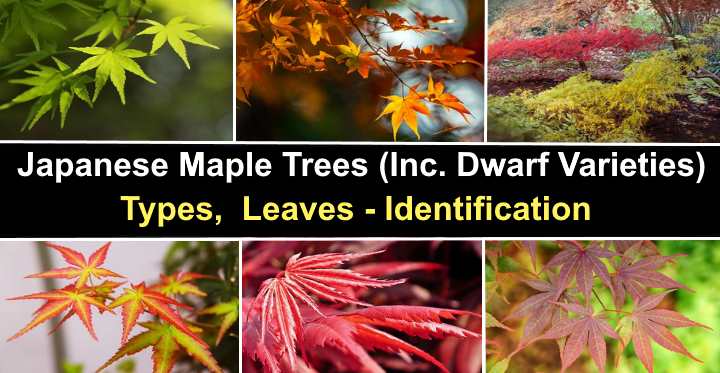
Japanese maple (Acer palmatum) trees are spectacular ornamental landscape trees with colorful palmate leaves. Japanese maples have foliage in stunning hues of red, gold, bright green, orange, and yellow. Unlike other maple varieties, Japanese maples are relatively small trees, with many colorful dwarf Japanese maple trees suitable for small, compact gardens or growing in containers.
This article is a complete guide to the best Japanese maple trees for growing in your garden. Descriptions and pictures of dwarf Japanese maples and weeping Japanese maples will help you choose the best one for growing in your garden landscape.
Japanese Maple Trees Facts
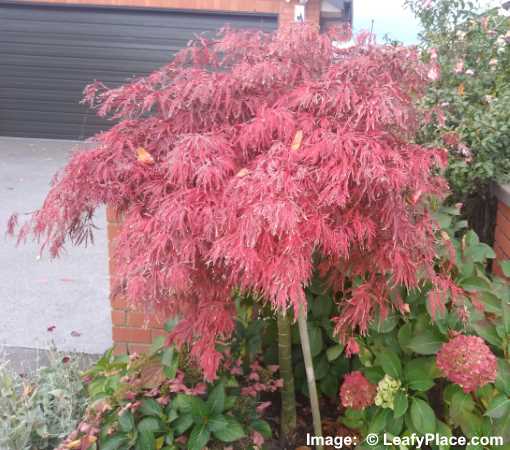
The ornamental Japanese maple tree provides stunning autumn color to enhance any garden landscape
Japanese maple trees are small flowering trees or large shrubs in the woody plant genus Acer. As their common name suggests, Japanese maples are native to Japan, Asia, and southeast Russia. Japanese maples are deciduous trees and shrubs that lose their leaves in the fall. The decorative maple trees are suitable for growing in USDA zones 5 through 9.
Japanese maples are identified by their rounded crown, palmately lobed leaves, and magnificent fall colors. Japanese maples can grow between 20 and 30 ft. (6 – 10 m); however, dwarf Japanese maples reach between 4 and 8 ft. (1.2 – 2.4 m). The maple leaves are 1.5” to 5” long (4 – 13 cm), and small clusters of flowers form in spring.
It’s easy to grow Japanese maple trees in a garden. The ornamental Japanese maple trees grow best in full sun to partial shade. The spectacular Japanese maple leaf colors are more vibrant when grown in part shade.
Japanese maple trees thrive in organically rich, well-drained, consistently moist soil.
How to Choose the Right Japanese Maple Tree

There are many types of Japanese maple trees to suit every garden
When choosing the perfect ornamental Japanese maple tree, consider the plant’s size, leaf shape, and leaf color.
Dwarf Japanese maples and weeping Japanese maples are ideal for small garden landscapes. Depending on the species, Japanese maples can have rounded, weeping, upright, or cascading branches. Taller Japanese maples are ideal specimen plants or lawn trees and perfect for providing shade.
The other considerations when picking a suitable Japanese maple tree is leaf size and color. Japanese maple leaves are palm-shaped, but the width of maple tree leaf blades ranges from broad to thin and lacy cut leaves that look like ferns.
Another consideration is choosing the color of your beautiful maple tree. Japanese maple leaves have spectacular colors in all seasons, ranging from red to yellow, pink, purple, burgundy, and brilliant yellow.
Japanese Maple Tree Leaves

Japanese maple leaves vary in their shape, color and size
There are two types of Japanese maple leaves: palm-shaped and delicate laceleaf (which is also called cutleaf or threadleaf maples). The characteristic of a Japanese maple leaf is the deep lobes, numbering between five and nine per leaf. Leaf blades have serrated edges and a pointed tip.
Palmate Japanese maples (Acer palmatum) have broad, serrated leaves with between five and nine lobes. The leaf shapes on Japanese palmate maples resemble leaves on typical maple trees, only with deeper lobes.
Laceleaf Japanese maples (Acer palmatum dissectum) have thin, pointed strap-like leaves with long narrow lobes. The individual lobes are dissected into smaller lobes. Compared to Japanese palmate maples, the laceleaf maple varieties have feather, fern-like leaves.
Another feature of a Japanese maple leaf is its spring, summer, and fall colors. Typically, Japanese maple tree leaves emerge in spring in one color and turn another color in summer before displaying vibrant fall colors. Japanese maple leaf colors can be deep red, purple-red, bronze, green, golden yellow, and orange. There are also species of variegated Japanese maple trees with bi-colored leaves.
Dwarf Japanese Maple Trees
Dwarf Japanese maple trees are ideal for small-scale landscaping or growing in containers. Dwarf ornamental Japanese maples can be naturally short trees or slow-growing specimens that take years to reach their mature height. Typically, dwarf Japanese maple trees grow between 4 and 8 ft. (1.2 – 2.4 m) tall.
Dwarf Japanese maples grow well in containers. Growing decorative maples this way lets you add color to patios, decks, or paved areas. Additionally, you can grow a container Japanese maple tree in USDA zone 4 and overwinter it indoors to protect it from frost.
Weeping Japanese Maple Trees
Weeping Japanese maple trees usually have a domed, umbrella-like crown with cascading colorful branches and lacy leaves. Weeping Japanese maples typically grow around 8 ft. (2.4 m) tall with a spread of 12 ft. (3.6 m). Because ornamental weeping maples take up less space than regular trees, they are also ideal for smaller gardens.
Some of the best weeping Japanese maple trees are Acer palmatum dissectum ‘Waterfall,’ Acer palmatum ‘Green Gem,’ and Acer palmatum ‘Viridis.’
Types of Japanese Maple Trees
Japanese maple trees are grouped into three main types—dwarf maples, weeping maples, and regular Japanese maples. There are also red Japanese maple trees and green Japanese maple trees.
All Japanese maples are identified by their lobed palmate or lacy leaves with serrated margins and five to nine deep lobes. Easy-care Japanese maples grow well in most landscapes with minimal fuss.
Varieties of Dwarf Japanese Maple
Here are some of the best dwarf Japanese maple trees to grow as a specimen tree or container plant in your yard.
Red Dragon Japanese Maple (Acer palmatum dissectum ‘Red Dragon’)
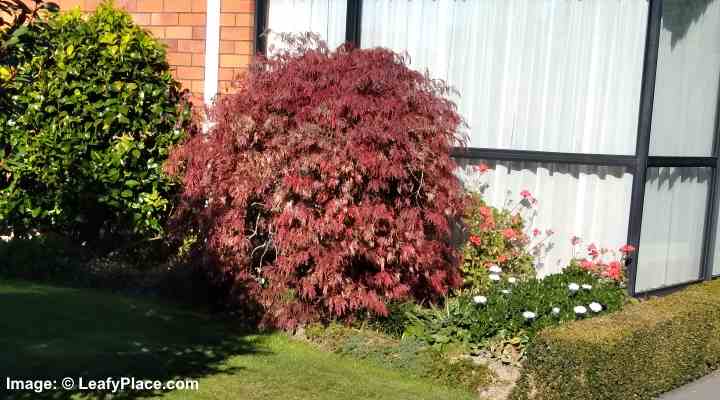
The dwarf ‘Red Dragon’ Japanese maple has weeping growth habit and beautiful red leaves
The Red Dragon maple cultivar is a laceleaf, small ornamental tree with purple-red dissected leaves that turn bright crimson red in the fall. The dwarf maple has a weeping habit with cascading branches that create a colorful centerpiece in a garden landscape. The ‘Red Dragon’ is a great dwarf Japanese maple tree for small gardens or containers.
The ‘Red Dragon’ Japanese maple tree thrives in full sun or part shade. It’s a slow-growing plant tree that matures at 6 to 8 ft. (1.8 – 2.4 m). Suitable for growing in USDA zones 5 to 8.
Japanese maple leaves: The dwarf ‘Red Dragon’ Japanese maple leaves are thin, red, dissected leaves that look like a dragon’s claw—hence its common name.
Crimson Queen Dwarf Japanese Maple (Acer palmatum dissectum ‘Crimson Queen’)
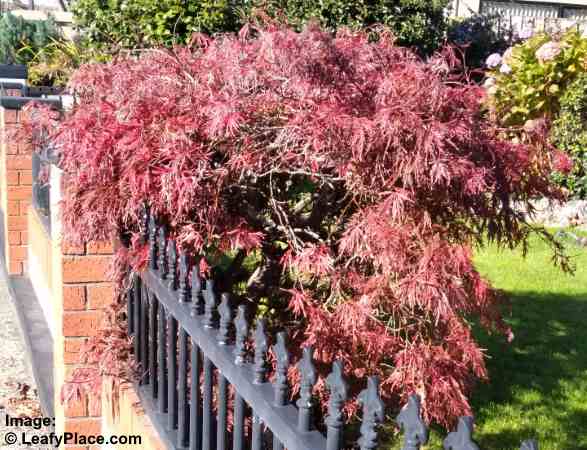
‘Crimson Queen’ dwarf Japanese maple tree is suitable for growing in full sun
The ‘Crimson Queen’ Japanese maple is a dwarf ornamental tree with burgundy-red lacy leaves that keep their color from spring to summer and turn very bright red in the fall. The laceleaf maple is tolerant of full sun and keeps its vibrant foliage colors despite strong sunlight. The mounding, cascading growth of the ‘Crimson Queen’ with its scarlet leaves creates a spectacular bushy maple plant.
The ‘Crimson Queen’ Japanese dwarf tree grows between 8 and 10 ft. (2.4 – 3 m) and up to 12 ft. (3.6 m) wide. Suitable for growing in full sun in USDA zones 5 to 9.
Japanese maple leaves: The ‘Crimson Queen’ Japanese leaves are bright red lacy leaves that keep their spectacular red colors through spring and early summer.
Inaba Shidare Dwarf Japanese Maple (Acer palmatum dissectum ‘Inaba Shidare’)
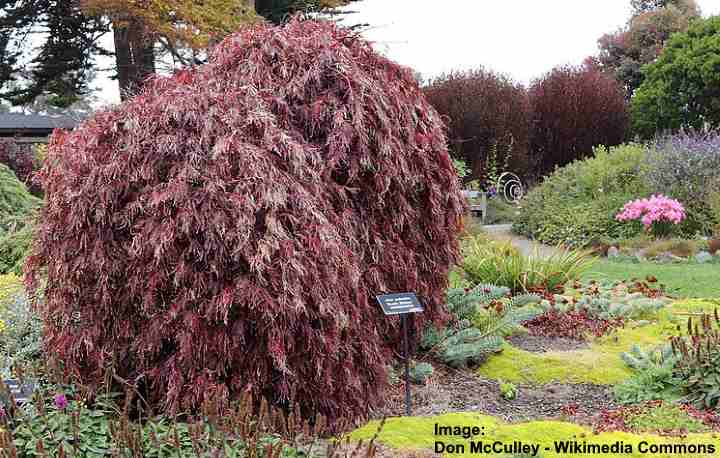
‘Inaba Shidare’ dwarf Japanese maple tree has deeply cut and dissected reddish-purple leaves
The bushy ‘Inaba Shidare’ Japanese maple is a small tree with cascading branches and red palmate leaves. Each Japanese maple leaf is 2” to 5” (5 – 12 cm) long with five or seven serrated lobes and typical lacy dissected foliage. The purple-red leaves turn stunning shades of deep purple, red, bronze, and yellow in the fall.
The ‘Inaba Shidare’ dwarf ornamental maple performs best in partial shade to full sun. The bushy dwarf maple tree takes ten years to grow between 4 and 6 ft. (1.2 – 1.8 m) tall. It eventually matures at 10 ft. (3 m). Suitable for zones 5 to 9.
Japanese maple leaves: The ‘Inaba Shidare’ maple leaves are deeply cut and dissected. The beautiful palmate foliage keeps its reddish-purple color throughout the season.
Shaina Japanese Maple (Acer palmatum ‘Shaina’)
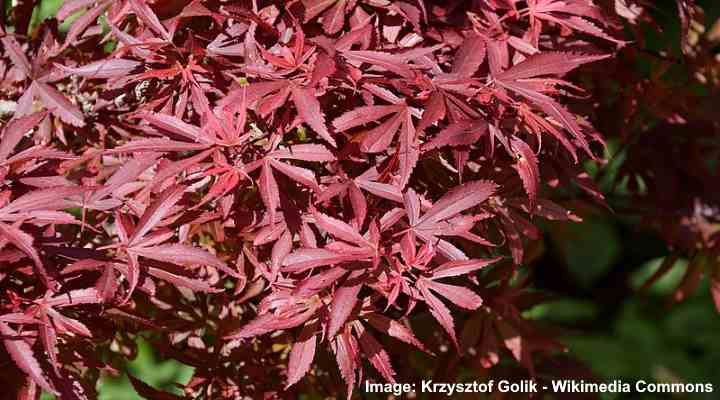
Shaina dwarf Japanese maple tree is ideal for compact gardens and small spaces
The stunning dwarf ‘Shaina’ Japanese maple is a compact, bushy tree with magnificent maroon-red leaves. The deeply lobed leaves emerge bright red in spring, turn dark purplish-red, then become crimson red in the fall. The dwarf Japanese maple ‘Shaina’ dark foliage creates an upright, rounded crown.
As a beautiful dwarf Japanese maple, the ‘Shaina’ cultivar grows between 4 and 6 ft. (1.2 – 1.8 m) tall and 4 ft. (1.2 ft.) wide. Ideal for USDA growing zones 5 to 9.
Growing in partial shade is best for maple leaf color, but the shrubby maple will withstand some full sun.
Discover many other types of Japanese maple trees.
Types of Japanese Maple Trees (Red Japanese Maples)
Here are some of the best red Japanese maple trees to fill gardens with stunning shades of crimson, burgundy, purple-red, and scarlet throughout the three growing seasons.
Bloodgood Japanese Maple (Acer palmatum var. atropurpureum ‘Bloodgood’)
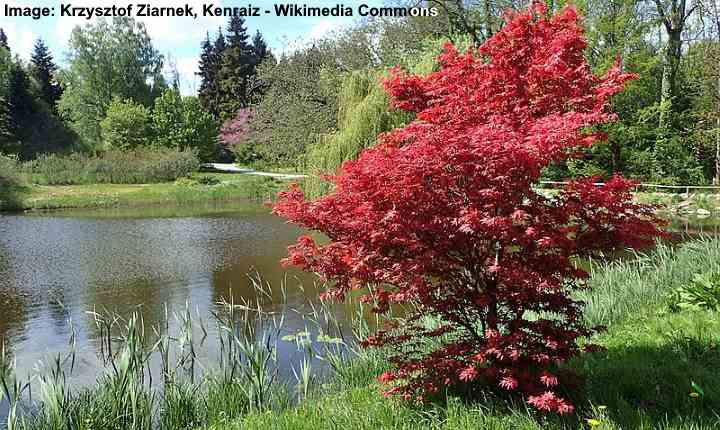
Bloodgood Japanese maple is a slow-growing decorative tree that adds a focal point to any garden
The ‘Bloodgood’ Japanese maple is a shrubby tree with rounded growth and deeply-lobed purple-red leaves. The Japanese maple leaf blades have five or seven tips and emerge as bright red before becoming wine-red or burgundy. Its upright growth, blackish-red bark, and globular crown give this beautiful Japanese maple tree all-year interest.
The ‘Bloodgood’ Japanese maple tree is a slow-growing plant that reaches between 10 and 20 ft. (4.5 – 6 m) high and wide. The easy-care ornamental maple tree doesn’t need pruning. Grow in full sun or partial shade in zones 5 to 8.
Japanese maple leaves: The ‘Bloodgood’ Japanese maple has red lobed leaves from spring until they drop in the fall. The maple leaf colors turn from bright red to dark maroon, then vibrant red in the fall.
Fireglow Japanese Maple Tree (Acer palmatum ‘Fireglow’)
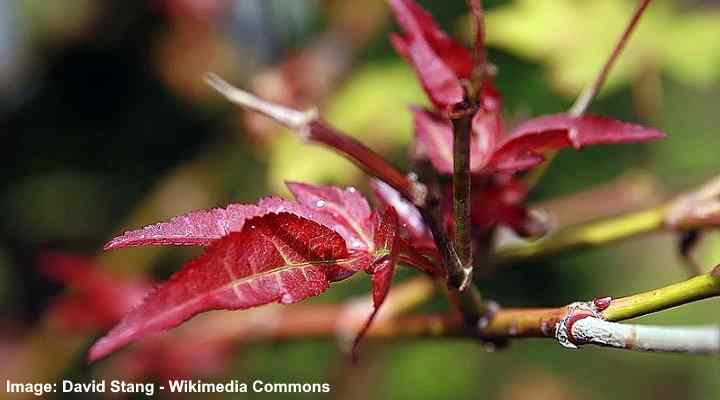
‘Fireglow’ Japanese maple is a small tree with stunning red leaves that can tolerate full sun
The ‘Fireglow’ red Japanese maple tree has stunning crimson red leaves lasting from spring until fall. The red maple leaves give this Acer palmatum cultivar its common name—‘Fireglow.’ Five to seven red lanceolate blades form the palmate leaves.
This maple cultivar looks similar to the Bloodgood maple but is smaller in size. The Fireglow Japanese maple takes ten years to grow between 6 and 10 ft. (1.8 – 3 m) tall and 15 ft. (4.5 m) wide. Suitable for growing in USDA zones 5 to 8.
Japanese maple leaves: The deeply lobed ‘Fireglow’ maple leaves have deep red colors that persist until fall. This leafy maple tree tolerates full sun without the leaves scorching.
Emperor Japanese Maple (Acer palmatum ‘Wolff’)

The Emperor Japanese maple tree has upright growth with leaf color that can be purplish-red or bright red
The Emperor Japanese maple tree is a fast-growing small tree with attractive palmate leaves ranging from burgundy-plum to rich red colors. Also called Emperor One and Red Emperor, this upright Japanese maple grows 10 to 15 ft. (3 – 4.5 m). The maple leaves keep their dark red colors throughout the season.
The maple is suitable for colder climates in zone 5 because the foliage is relatively frost-tolerant. Ideal for growing in full sun without suffering from sun scorch.
Japanese maple leaves: The Emperor Japanese maple has large palm-like leaves that have five lobes and serrated edges. The Japanese maple leaf colors can be purple, wine red, or bright red.
Laceleaf Japanese Maple (Acer palmatum ‘Dissectum Atropurpureum’)
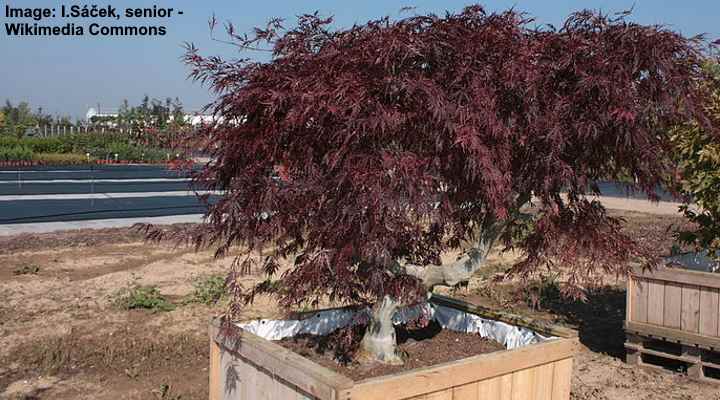
Laceleaf Japanese Maple
The Laceleaf Japanese maple ‘Atropurpureum’ is a large shrubby, rounded maple tree with thin fern-like leaves dissected into small lobes. The beautiful wiry maple leaves emerge deep purple before turning bronze-green, then fiery orange in the fall. The Laceleaf maple grows between 6 and 8 ft. (1.8 – 2.4 m) tall and wide. Suitable for USDA zones 5 to 8.
Garnet Laceleaf Japanese Maple (Acer palmatum dissectum ‘Garnet’)

‘Garnet’ laceleaf Japanese maple
The ‘Garnet’ Japanese maple tree is a laceleaf variety with stunning red leaves that are deeply cut, long, thin, and pointed. The vigorous ‘Garnet’ maple tree has a spreading crown with drooping branches creating a stunning rounded red tree canopy. Matures at 6 to 8 ft. (1.8 – 2.4 m) tall and up to 12 ft. (3.6 m) wide.
Orange Dream Japanese Maple (Acer palmatum ‘Orange Dream’)
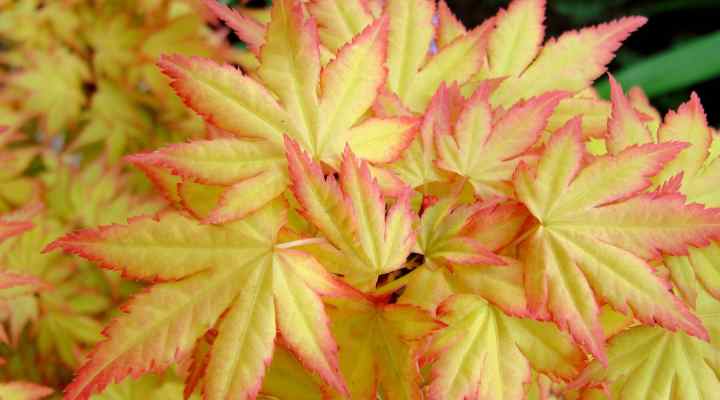
‘Orange Dream’ Japanese maple
The ‘Orange Dream’ Japanese maple tree has spectacular palmate leaves that are golden yellow with tinges of pink that turn greenish-yellow in summer. The ‘Orange Dream’ Japanese maple is a small shrubby tree growing between 8 and 10 ft. (2.4 – 3 m) tall and 6 ft. (1.2 m) wide.
Grow the ‘Orange Dream’ decorative maple in full sun or partial shade in USDA zones 5 to 8. This small maple tree is ideal for adding bright colors to small gardens or growing in pots.
Ornatum Japanese Maple (Acer palmatum ‘Ornatum’)
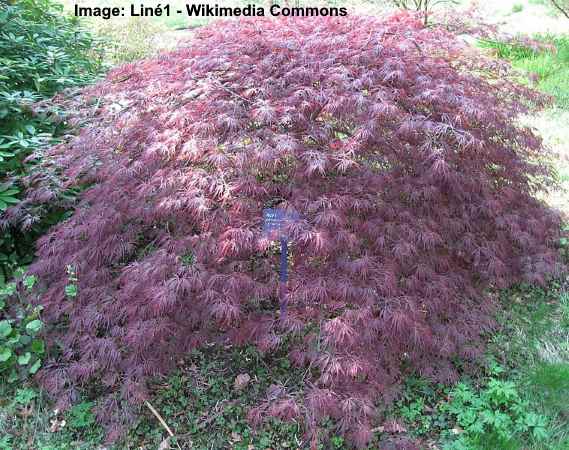
Ornatum Japanese maple
The ‘Ornatum’ Japanese maple has delicate bronze-red lacy leaves with long thin lobes in spring. The foliage turns bronze-orange in summer and bright red in fall. The Ornatum maple tree has a rounded growth habit. It is a slow growing Japanese maple that grows up to 10 ft. (3 m) tall with a spread of 8-10 ft. (2.4 – 3 m).
Grow in full sun to part shade in moist and well-drained soil in zones 5 – 8.
Red Pygmy Japanese Maple (Acer Palmatum ‘Red Pygmy’)
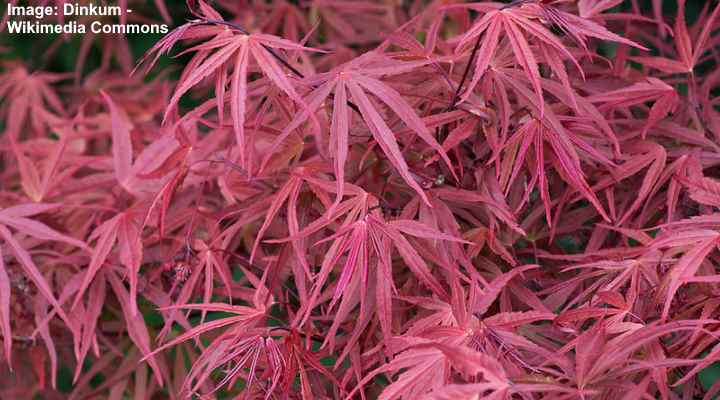
Red Pygmy Japanese maple
The ‘Red Pygmy’ Japanese maple has an attractive rounded shape with seven lobed leaves that are reddish-purple in spring and then turn to dark green in summer and golden-yellow in the fall.
The ‘Red Pygmy’ is a slow-growing maple tree that can reach height of 5 – 7 ft. (1.5 – 2.1 m) and spread of 4 – 6 ft. (1.2 – 1.8 m). Grow it in moist but well-drained soil in USDA zones 5 – 8.
Types of Green Japanese Maple Trees
Green Japanese maple trees are attractive ornamental small trees suitable for all garden sizes. The feature of green Japanese maples is that they have green leaves in the summer. However, the leaves can emerge in spring in various shades of green and then turn yellow to red in the fall.
Viridis Green Japanese Maple (Acer palmatum dissectum ‘Viridis’)
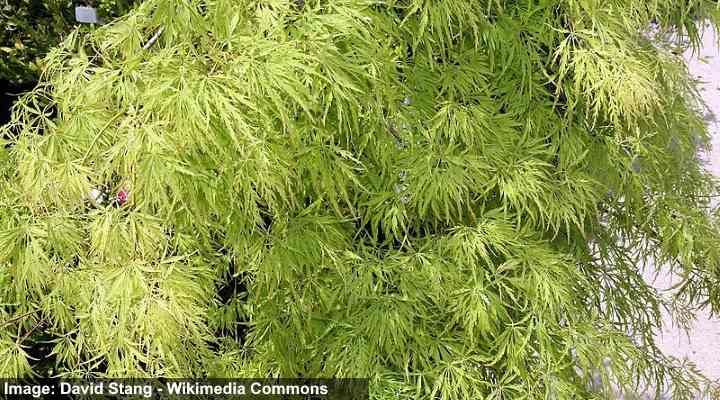
Viridis Japanese maple has bright green leaves in spring and summer that turn yellow or orange in the fall
The ‘Viridis’ Japanese maple is a dwarf, multi-stemmed tree with lace-like leaves made up of thin, spiky-looking blades. The laceleaf or cutleaf Japanese maple tree leaves are bright green in spring and summer before turning golden yellow or orange in the fall. The crooked maple tree trunk and branches give the Japanese maple visual interest in winter.
The ‘Viridis’ Japanese maple grows best in dappled sunlight. It’s a slow-growing maple that eventually matures between 8 and 10 ft. (2.4 – 3 m) tall and 8 ft. (2.4 m) wide. Suitable for growing in zones 5 to 8.
Japanese maple leaves: The stunning wiry-looking green maple leaves on the ‘Viridis’ Japanese maple are finely cut leaves in shades of yellow, red, and orange in the fall.
Coral Bark Japanese Maple Tree (Acer palmatum ‘Sango-Kaku)
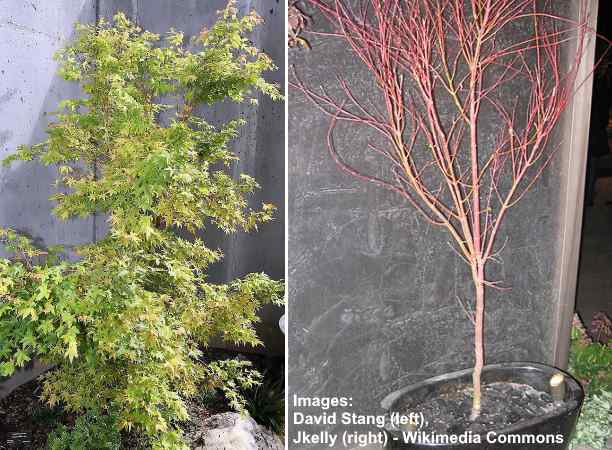
Coral Bark Japanese maple tree gets its name from the beautiful color of its bark
The Coral Bark Japanese maple is a small, multi-stemmed tree with stunning coral-red bark, yellow, five-lobed leaves, and a vase-shaped growth habit. The outstanding feature of the coral bark maple is the bright, vibrant yellow palmate leaves contrasting with reddish-pink bark.
This green Japanese maple is suitable for growing in USDA zones 5 to 8. As a slow-growing maple, the Acer palmatum ‘Sango-Kaku’ takes many years to mature at 20 and 25 ft. (6 – 7.5 m) tall and up to 20 ft. (6 m) wide.
Japanese maple leaves: Coral bark Japanese maple ‘Sango-Kaku has ferny leaves 2” (5 cm) long. They emerge yellowish-green, turn light green, then change to golden yellow in the fall.
Osakazuki Japanese Maple (Acer palmatum ‘Osakazuki’)
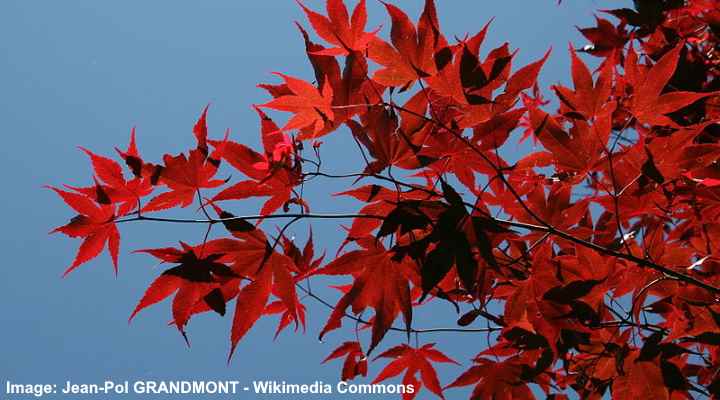
‘Osakazuki’ Japanese maple has green foliage in summer that turns red in the fall
The ‘Osakazuki’ Japanese maple is a small, rounded maple tree with a bushy appearance. The palmate maple leaves have 5 or 7 lobes with serrated edges. As a variety of green Japanese maple, the tree’s color is green in the summer. However, the leaves turn a stunning crimson red for a few weeks before they drop in the fall.
‘Osakazuki’ Japanese maple trees grow between 15 and 25 ft. (4.5 – 7.5 m) tall and up to 15 ft. (4.5 m) wide. The ‘Osakazuki’ maple grows well in full sun without suffering from sun scorch. Suitable for USDA zones 5 to 8.
Japanese maple leaves: The ‘Osakazuki’ Japanese maple leaf has seven pointed lobes. The green leaves turn a brilliant deep orange or vibrant blood-red color in the fall.
Butterfly Japanese Maple (Acer palmatum ‘Butterfly’)

‘Butterfly’ Japanese maple has green and creamy-white variegated leaves
One of the most stunning Japanese maple trees is the Acer palmatum ‘Butterfly.’ The unique feature of the ‘Butterfly’ Japanese maple is its creamy-white and green variegated lobed leaves. Some maple tree leaves are bi-colored, whereas others are all solid cream-colored blades. The fancy serrated leaves emerge with hints of pink coloring in spring.
In fall, the ‘Butterfly’ Japanese maple turns bright scarlet to magenta. The shrubby maple tree grows between 7 and 12 ft. (2.1 – 3.6 m) tall and up to 8 ft. (2.4 m) wide.
Waterfall Weeping Japanese Maple Tree (Acer palmatum dissectum ‘Waterfall’)

‘Waterfall’ weeping Japanese maple tree
The ‘Waterfall’ Japanese maple is a small, weeping maple tree with ferny, lace-like cut leaves, each having between seven and 11 incised lobes. The laceleaf Japanese maple feathery leaves are green and turn outstanding shades of red, purple, yellow, and bronze in the fall.
A characteristic of the ‘Waterfall’ weeping maple is its vast, spreading canopy. The rounded, umbrella-like crown measures up to 12 ft. (3.6 m) wide, and the dwarf maple is 6 to 10 ft. (1.8 – 3 m high).
Full Moon Japanese Maple Tree (Acer shirasawanum ‘Aureum’)
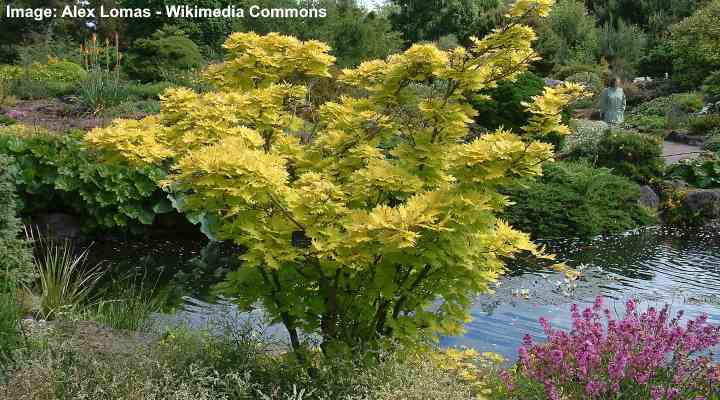
Full Moon Japanese maple tree
The ‘Aureum’ Japanese maple is a small tree with green leaves that turn orangey-bronze in the fall. The identifying characteristic of the Golden Full Moon maple is the fan-like leaves with shallow lobes. The ‘Aureum’ maple tree grows between 15 and 20 ft. (4.5 – 6 m) tall and wide. However, it’s a slow-growing tree that takes many years to reach maturity.
Seiryu Japanese Maple (Acer palmatum ‘Seiryu’)
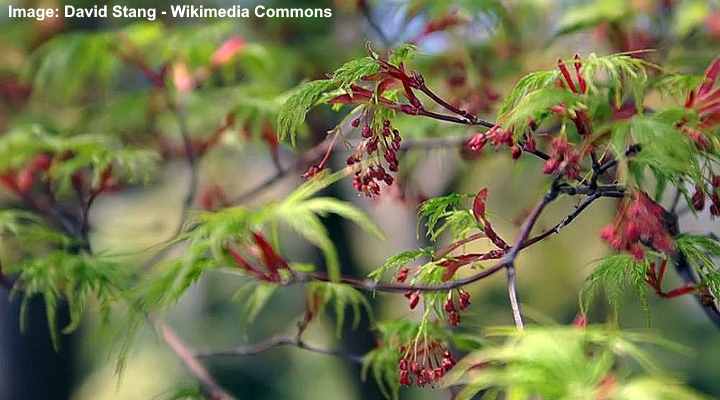
Seiryu Japanese maple
The ‘Seiryu’ Japanese maple is a threadleaf variety with super-thin dissected leaves that are green with pinkish tips. The Japanese maple leaves emerge lime-green in spring and turn orange-red in the fall. The cultivar name of this Japanese maple means ‘Blue-Green Dragon’—referring to the resemblance of the green cut maple leaves to a dragon’s claw.
The ‘Seiryu’ Japanese maple tree grows between 10 and 15 ft. (3 – 4.5 m) tall and 8 – 12 ft. (2.4 – 3.6 m) wide. The unusual characteristic of the ‘Seiryu’ maple is its broadly columnar growth habit.
Acer palmatum ‘Kagiri-nishiki’
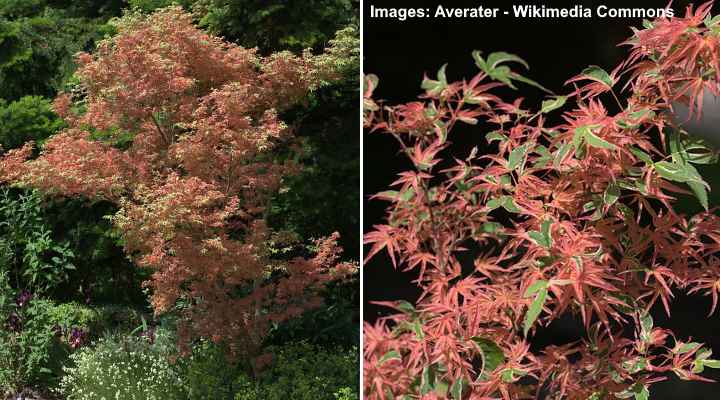
Acer palmatum ‘Kagiri-nishiki’
‘Kagiri-nishiki’ is a beautiful Japanese maple tree with variegated green and white foliage with a hint of pink margins that turn pink and red-crimson in the fall.
‘Kagiri-nishiki’ Japanese maple has a relatively round form. It is a slow growing tree that can reach a height of up to 20 ft. (6 m) with similar spread. Grow in full sun to partial shade in USDA Zone 5 – 8.
Related articles:
